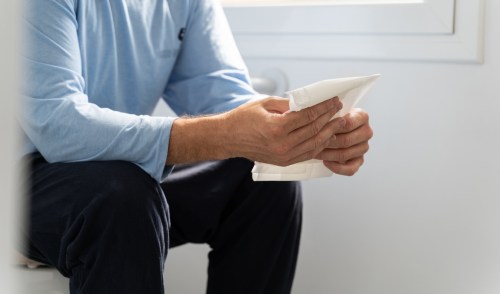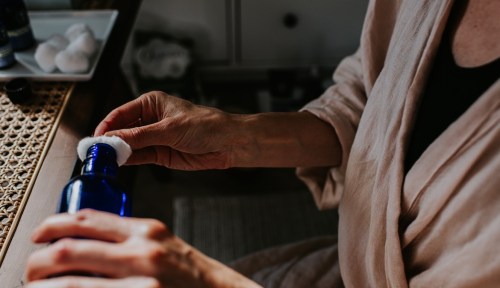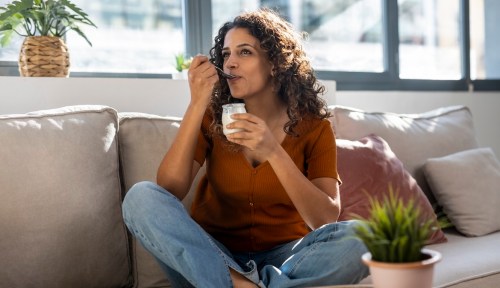How the low-FODMAP diet helped Alyce Crawford soothe her IBS pain and bloating
Model and trainer Alyce Crawford explains how the low-FODMAP diet helped soothe her IBS pain and bloating—and shares her favorite low-FODMAP snacks and recipes.

Judging by her Instagram grid—filled with gym videos, chocolate smoothies, and stunning selfies—you’d never guess that Australian model and trainer Alyce Crawford lives with irritable bowel syndrome (IBS). And, for a long time, she didn’t realize it, either. Crawford experienced severe bloating and intense stabbing pains in her stomach for four months until she finally saw a family doctor, who diagnosed her with the chronic condition.
“Because I was living in America at the time, I thought the cause may have been the food I was eating,” Crawford says. “I woke up one morning and my stomach didn’t feel right. I could tell that the bloating I was experiencing wasn’t like the usual bloat people get occasionally.”
Doctors still don’t know exactly what causes IBS, a disease with symptoms such as excess gas, diarrhea or constipation, and cramping. And unfortunately, there aren’t any specific medications that can treat the condition, so people living with it—25-45 million in the US alone, up to 65 percent of them female—are left trying to solve the mystery with elimination diets and complementary therapies.
This was certainly the case for Crawford. “I wasn’t told enough information about what IBS was and how I got it. From that moment on, I was convinced that what I had wasn’t, in fact, IBS but something else,” she says. The model met with different doctors to rule out any other digestive health issues, but after countless tests that led nowhere, she was frustrated and tired. “I was so disheartened and felt like I had literally hit rock bottom,” Crawford says.
But then, she made a discovery that turned her health around—and unwittingly led her to become an inspiration for countless other IBS sufferers in the process.
Keep reading to find out how Alyce Crawford learned to treat her IBS symptoms naturally.
The low-FODMAP diet and IBS
Crawford eventually met with Joanna Turner, a health coach based in Sydney, who put her on the low-FODMAP diet—one that restricts foods high in fermentable oligosaccharides, disaccharides, monosaccharides and polyols. These compounds are linked to bloating and found in tons of different foods, including onions, garlic, apples, dates, gluten-containing grains, beans, and dairy products.
Crawford experienced a pretty steep learning curve, as you can imagine. (Try going to a restaurant and finding something without onions or garlic in it.) “I had no idea how to eat while I was following it. I lived off rice cakes and bananas,” she says. But after following a daily, low-FODMAP meal plan developed by Turner, Crawford started to feel better—and now, she’s better able to manage her IBS symptoms.
Many other IBS sufferers have found relief from laying off the FODMAPs, too. A 2017 study from the International Journal of Preventive Medicine suggests that the diet can help control IBS symptoms, but more research is needed to show its long-term effects.
Crawford’s favorite low-FODMAP foods and recipes
Once she learned the ropes of low-FODMAP cooking, Crawford found that it wasn’t as intimidating as she once thought. “Following a low-FODMAP diet forced me to become creative in the kitchen. I started to experiment with some of my favorite meals, like spaghetti bolognese,” she says. Since pasta, garlic, onions, and Italian sausage are all high-FODMAP foods, Crawford uses fresh chives and smoked paprika for flavor and makes her own pasta sauce with crushed tomatoes and herbs. “After I got used to swapping ingredients, I realized how many of my favorite meals I could do this for,” she says.
Crawford also stocks up on low-FODMAP prepared foods, like FODY nut bars. “I find it hard to stop at one bar. They’re so delicious and easy to pack with me when I’m out,” she says. She also likes their tomato salsa, ketchup and other seasonings. Finding good substitutes for high-FODMAP foods is key because Crawford tries to avoid “cheat days.” “Some days are harder than others, but I’ve honestly learned how to adapt,” she says.
That’s because when she does sneak in a few high-FODMAP foods, she pays a pretty major price. In a recent Instragram post, Crawford shared how much pain and bloating she experienced after celebrating her birthday with cake, chocolate, and wine. The next day she resumed her low-FODMAP diet, and about five days later, the bloating finally subsided. She’s dreaming of the day when she’ll be able to find low-FODMAP dupes for her favorite foods everywhere. “I only hope that in the future, more restaurants, cafés, and food companies acknowledge the low-FODMAP diet and contribute to this growing market,” she says. At least the low-FODMAP community has her Insta-advice to rely on until then.
Here are 5 doctor-approved foods to eat if IBS is taking over your life. And for your busiest days, you can make this low-FODMAP quesadilla recipe in less than 10 minutes.
Sign Up for Our Daily Newsletter
Get all the latest in wellness, trends, food, fitness, beauty, and more delivered right to your inbox.
Got it, you've been added to our email list.










